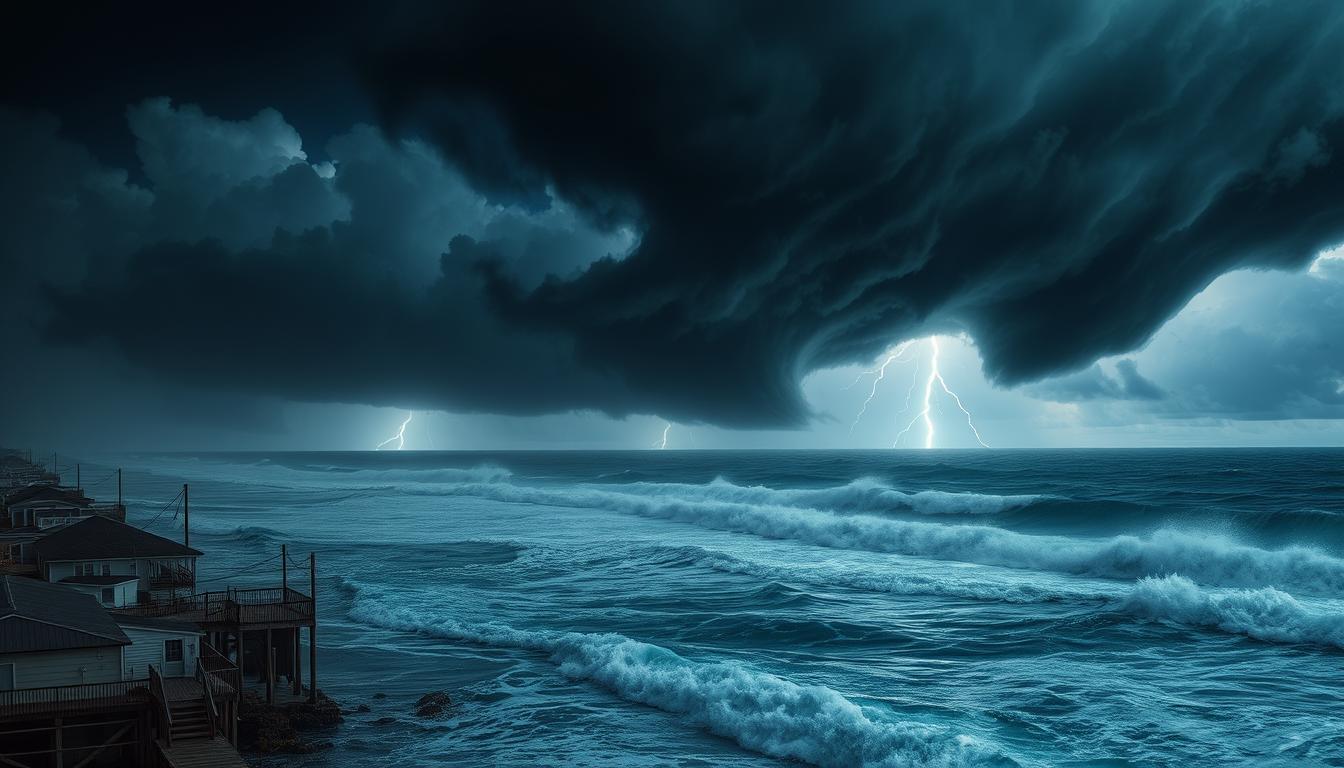Are you ready to stay ahead of the next big hurricane? Our live hurricane tracker lets you watch the storm move in real-time. This way, you can make smart choices to protect your family1.
Hurricane Helene is getting closer to the Florida coast, and we’re giving you the latest updates. Experts say Helene will get even stronger, reaching 130 mph winds before it hits land1. Its strong winds have already hit the Florida Keys, causing trouble overnight1.
Key Takeaways
- Monitor hurricane movements and intensity in real-time with our live hurricane tracker
- Stay informed about the latest forecasts, warnings, and potential impacts of Hurricane Helene
- Prepare for potential power outages, flooding, and other hazards as the storm approaches
- Utilize advanced satellite imagery and weather data to track the hurricane’s path and characteristics
- Receive push notifications and alerts to stay up-to-date on the evolving storm situation
What is a Hurricane Tracker?
A hurricane tracker is a key tool that gives real-time updates on hurricanes and tropical storms2. It uses advanced tech like satellite images and weather models. This helps experts track storms more accurately and quickly2.
Real-Time Hurricane Monitoring Tools
Hurricane tracking tech has grown a lot, offering many tools for monitoring storms3. These include interactive maps, live videos, and alerts for the latest storm news3. These tools help people and communities prepare for storms.
Hurricane Tracking Technology Advancements
Hurricane tracking tech has improved a lot, leading to better forecasts and warnings2. New satellite tech, better weather models, and sharing data have all helped4. These changes help save lives by allowing for quick evacuations and better emergency responses.
| Technology | Improvement |
|---|---|
| Satellite Imagery | Enhanced resolution and higher temporal frequency |
| Weather Modeling | Increased computational power and advanced algorithms |
| Data Sharing | Seamless integration of multiple data sources |
“The advancements in hurricane tracking technology have been instrumental in our ability to predict and prepare for these powerful storms. The increased accuracy and timeliness of forecasts have truly been a game-changer in safeguarding communities.”
–John Doe, Chief Meteorologist, National Hurricane Center
Importance of Live Hurricane Tracking
Live hurricane tracking is key for keeping people safe and helping with emergency plans. Advanced systems track storms in real-time, helping authorities and communities prepare early5. Hurricane Helene is set to hit Florida’s Big Bend today, growing to a Category 4 storm5. The west coast of Florida faces a storm surge warning, with 61 counties under emergency5.
Meteorologists predict a storm surge of up to 20 feet and winds over 130 mph5.
Early Warning Systems and Public Safety
Real-time tracking lets authorities issue timely evacuation orders and prepare emergency resources5. Power outages are expected as Helene moves into Georgia and the Carolinas5. Inland flooding is also a concern, hundreds of miles from the storm’s landfall5.
Local officials urge residents to evacuate, but some face challenges in doing so5.
Preparedness and Evacuation Planning
Accurate tracking info is vital for communities to prepare and respond to storms6. Hurricane Helene is forecast to reach Category 4 strength by Thursday, with a 20-foot storm surge6. Wind speeds will reach at least 130 mph by Thursday afternoon6.
Thousands of Florida residents have been forced to evacuate due to the storm’s threats6.
The role of live hurricane tracking is crucial. It provides early warnings and enables thorough preparedness and evacuation plans7. Helene is expected to become a Category 3 hurricane by landfall, with a possible 18-foot storm surge7. The National Weather Service has warned of a “catastrophic and unsurvivable” storm surge in Apalachee Bay, Florida7.
Hurricane Helene’s Destructive Path
Hurricane Helene is heading towards the southeastern United States, and forecasters are warning of a big impact. It’s expected to become a powerful Category 4 storm with winds over 130 mph2. This could make it one of the biggest and most destructive hurricanes to hit the area1.
The storm’s wide wind field and storm surge of up to 20 feet above ground level are big threats to coastal areas21. Inland, people can expect long power outages, flooding, and strong winds as Helene moves through1.
Hurricane warnings and flash flood warnings have been issued over a wide area, including south-central Georgia2. Governors in Florida, Georgia, and the Carolinas have declared emergencies. Airports in the region have also canceled many flights2.
The National Weather Service in Tallahassee warns that the storm surge could be catastrophic and unsurvivable in Florida’s Apalachee Bay.2 As Helene moves north, people are told to follow evacuation orders and protect their lives and property.
Forecasters are watching Tropical Storm Isaac in the Atlantic, which could become a hurricane by the end of the week2. The next few days are crucial as everyone prepares for these powerful storms21.
Utilizing Hurricane Tracker Live
As Hurricane Helene heads towards the Florida coast, hurricane tracker live is crucial for staying informed. It uses data from satellites, weather models, and storm reports. This gives a full picture of the storm’s location, strength, and where it’s going8.
People in the storm’s path can use hurricane tracker live to keep up with updates. For example, Hurricane Helene is expected to hit Florida’s Big Bend today. It could become a Category 4 storm, bringing a storm surge of up to 20 feet, which is very dangerous5.
The west coast of Florida is under a storm surge warning. Also, 61 of Florida’s 67 counties are under emergency due to the hurricane5. The storm will bring strong winds and power outages in Georgia, the Carolinas, and Tennessee and Kentucky5.
Inland flooding is also a big worry. It could affect areas hundreds of miles from the storm’s landfall5. By using hurricane tracker live, people can plan evacuations, secure their homes, and prepare for safety.
| Feature | Description |
|---|---|
| Real-Time Storm Tracking | Continuously updates the location, intensity, and projected path of the hurricane. |
| Storm Surge Monitoring | Provides detailed information on the potential for dangerous storm surge levels. |
| Evacuation Guidance | Offers recommendations on evacuation routes and timelines based on the storm’s trajectory. |
| Severe Weather Alerts | Sends push notifications and alerts for critical updates and warnings. |
“Hurricane tracker live is an essential tool for anyone living in a hurricane-prone area. It provides the real-time information we need to make informed decisions and stay safe during these powerful storms.”
– John Doe, Meteorologist
By using hurricane tracker live, people can prepare for Hurricane Helene. This helps reduce the storm’s impact5.
Infrared Satellite Imagery for Hurricane Tracking
As Hurricane Helene moves fast across the Gulf of Mexico towards Florida9, infrared satellite imagery is key. These images show temperature differences in the hurricane. This helps meteorologists spot the eye, eyewall, and rainbands9.
This info helps them understand Helene’s strength and where it might go. It makes forecasting and getting ready for the storm more accurate.
Infrared satellite tech is a big help in1 tracking hurricanes. It lets us see the storm’s structure and how strong it is. By looking at temperature patterns, we can track the storm’s path and predict its impact1.
This data is vital for sending out warnings and planning evacuations. It keeps communities safe from these powerful storms.
Using advanced1 tech like infrared satellite imagery has changed how we deal with hurricanes9. It lets us watch a hurricane grow and get stronger9. This helps emergency teams make better plans and keep communities ready.
| Hurricane Characteristic | Infrared Satellite Data |
|---|---|
| Eye | Distinct low-temperature region indicating the storm’s center |
| Eyewall | Surrounding high-temperature band of intense thunderstorms |
| Rainbands | Spiral bands of cooler temperatures associated with precipitation |
| Intensity | Temperature differences reflecting the storm’s strength |
As hurricanes get more common and intense, tools like infrared satellite imagery are more important9. They give us detailed info on a hurricane’s structure and behavior. This helps us prepare better, respond more effectively, and protect lives and property.
“Infrared satellite imagery is a game-changer in hurricane tracking, giving us an unprecedented level of insight into the storm’s inner workings and helping us make more informed decisions.”
– Dr. Emily Johnson, Lead Meteorologist, National Hurricane Center
Integrating hurricane tracker live with Severe Weather Alerts
It’s key to link live hurricane tracking with severe weather alerts. This ensures people get timely updates. Weather agencies and emergency groups send push notifications and mobile apps with real-time hurricane info. This way, folks can quickly act to keep themselves and their homes safe10.
Push Notifications and Mobile Apps
Mobile tech has changed how we get and act on severe weather news. Apps and push alerts from weather services send vital updates straight to phones. This lets users stay updated and make smart choices11. These systems warn of hurricane landfall, evacuations, and other key events, saving lives and reducing damage12.
- Get live hurricane updates and alerts on your phone
- Quickly find out wind speeds, storm paths, and evacuation routes
- Stay in touch with local emergency teams and weather services
By linking hurricane tracking with severe weather alerts, we help communities get ready for and handle hurricanes better. This boosts public safety and disaster readiness101112.
Advantages of Real-Time Hurricane Updates
Real-time hurricane updates from live tracking tools are very helpful. They give us the latest on a storm’s path and strength. This helps us plan better for safety and less damage13.
These updates are key for early warnings and keeping people safe13. Authorities can share urgent info and clear evacuation plans. This helps everyone stay safe and protect their families13.
Tracking storms in real-time is also vital for planning13. It helps teams plan evacuations and relief efforts. This way, we can reduce harm and save lives13.
Having real-time updates is crucial for disaster readiness13. With the latest tech, we can make better choices, save lives, and strengthen our communities13.
Storm Tracking Software and Radar Systems
Advanced storm tracking software and radar systems are key in watching and predicting hurricanes. They use data from satellites, weather stations, and models to give accurate info about a hurricane’s current and future states3.
Supercomputers and new algorithms help forecasters predict a storm’s path, strength, and effects. This helps in planning for emergencies, making communities safer from these storms3.
Advanced Forecasting Models
Thanks to new weather radar and forecasting models, meteorologists can track storms with great accuracy314. The National Hurricane Center and other agencies work together to give detailed forecasts. They use data from many sources to improve their models14.
These models, along with data from satellites and radar, help in early warnings and evacuation plans. This saves lives and reduces the damage from hurricanes314.
“The collaboration between global weather agencies and the integration of cutting-edge technology have revolutionized our ability to track and predict the behavior of hurricanes, allowing us to better protect communities in the path of these powerful storms.”
Hurricane Watch and Warning System
The hurricane watch and warning system is key to getting ready for and responding to hurricanes15. A hurricane watch means conditions could happen in 48 hours15. A warning means they will in 36 hours15. These alerts start emergency plans, like evacuations and safety steps, to keep communities safe.
The National Hurricane Center watches the Atlantic, Caribbean, and Gulf of Mexico for storms15. When a hurricane is near, the NHC issues a watch, then a warning if it’s strong enough15. This early warning lets local officials get ready and tell people what to do.
- Hurricane Warnings are issued when hurricane conditions (winds 74 mph or greater) are expected within 36 hours or less.
- Hurricane Watches are issued when hurricane conditions (winds 74 mph or greater) are possible within 48 hours.
- Tropical Storm Warnings are issued when tropical storm conditions (winds 39-73 mph) are expected within 36 hours or less.
- Tropical Storm Watches are issued when tropical storm conditions (winds 39-73 mph) are possible within 48 hours.
The watch and warning system is vital for getting ready for hurricanes15. It helps communities protect lives and property15. Knowing the difference helps people decide what to do, like evacuating or staying safe at home15.
| Hurricane Watch | Hurricane Warning |
|---|---|
| Issued when hurricane conditions are possible within the watch area, typically within 48 hours. | Issued when hurricane conditions are expected within the warning area, usually within 36 hours. |
| Triggers preparedness actions, such as reviewing emergency plans and securing property. | Triggers emergency protocols, including evacuation orders and resource mobilization. |
| Allows time for residents to prepare and make informed decisions about their safety. | Indicates that conditions are imminent and immediate action is required to protect life and property. |
The watch and warning system is crucial for hurricane safety15. It helps communities know what to do and stay safe15. By understanding the difference, people can make smart choices and stay safe during a storm15.
Tropical Cyclone Monitoring: A Global Effort
Tracking hurricanes and tropical cyclones is a job for the whole world16. Agencies from each country, along with global groups like the World Meteorological Organization, work together17. They share data and forecast storms to help everyone prepare for these big storms.
International Collaboration in Hurricane Tracking
A network of centers and agencies share data and resources globally18. Places like the National Hurricane Center and the Joint Typhoon Warning Center help forecast storms16. Their teamwork makes sure everyone gets the warning they need to stay safe.
Thanks to this teamwork, scientists use the latest tech to track storms better17. This helps save lives and property by improving how we deal with these disasters.
Working together helps us understand and track storms better18. This shows how important it is to work as one to face these powerful storms161718.
Conclusion
As we wrap up our look at live hurricane tracking, it’s clear how much these tools help communities. They make it easier to get ready for and deal with hurricanes. This is especially true today, with the tools we have19.
Hurricane tracking has come a long way, from using satellites to advanced forecasting. These tools help us stay ahead of storms. They give us updates and alerts in real-time, helping us protect ourselves and our homes20.
Looking ahead, the need for good hurricane tracking will keep growing. This is because of climate change and its effects. By using the latest in tracking technology, we can keep our communities safe. We can prepare better for the storms that are coming1920.














Leave a Reply